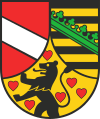Weimar-Orlamünde county

The county of Weimar-Orlamünde was an independent political entity on the territory of what is now Thuringia . It consisted of the unconnected territories of the County of Weimar and the County of Orlamünde. The regents were called either Counts of Orlamünde or Counts of Weimar-Orlamünde.
history
House Weimar-Orlamünde
Count Otto I from the older line of the Counts of Weimar came into the possession of the County of Orlamünde around 1060 . When Otto's older brother, Count Wilhelm IV, who ruled in Weimar, died childless in 1062, Otto also received the county of Weimar. Since then, the two areas were connected as the county of Weimar-Orlamünde. With the death of Count Ulrich II, the older line of the Counts of Weimar-Orlamünde died out in 1112.
House of Ascania
The right to inherit was Count Palatine Siegfried von Ballenstedt , son of Count Palatine Adelheid von Weimar-Orlamünde († March 28, 1100), a daughter of the aforementioned Count Otto I. Since this with Count Adalbert II von Ballenstedt (the grandfather of Albrecht the Bear ) from the Family of the Askanians was married, Weimar-Orlamünde fell to Adalbert's son Siegfried von Ballenstedt († 1113) after a few inheritance disputes, in which Emperor Heinrich V also intervened. After his death it came to a branch line of the Ascanians and in 1140 to Albrecht the Bear.
During the division of inheritance in the House of Askania after the death of Albrecht the Bear in 1170, a younger line of the Counts of Weimar-Orlamünde was created after Hermann I (1140–1176), a younger son of Albrecht the Bear.
Under his grandson Hermann II (1180–1247), he ruled Weimar from 1206, the county flourished again briefly. Hermann II was the husband of Beatrix, heir daughter of Andechs-Meranien . As a result of their legacy, Orlamünder territorial possessions extended from Weimar and the Schauenforst castle over the Orlagau to Orlamünde and Rudolstadt and partly incoherent dominions, estates and rights in the Thuringian Slate Mountains and in the Franconian Forest as far as the Kronach , Plassenburg and Nordhalben area . The Counts of Weimar-Orlamünde began building their own sovereignty, but too late to be able to assert themselves against the Thuringian landgraves from the up-and-coming Wettin family . After Hermann's death the county was transferred to his two sons Hermann III. († 1283) and Otto III. († 1285) divided. Due to the division, the counts were also weakened in their dispute with the Wettins, and there were also pressing financial problems. This led to the fact that the Hermann III. returning Orlamünder line had to sell Orlamünde on April 27, 1344 to Wettin.
The Otto III. The Weimar Line, which was founded, lasted until 1346, when Friedrich I, a grandson of Otto III, was defeated by the Wettins in the Thuringian Count's War and had to give them the county of Weimar as a fief . This ended the county of Weimar as a direct imperial, i.e. independent political unit. The Counts of Weimar were vassals of the Wettins until the main line died out. After the death of the last Weimar count, the Wettin Weimar moved in as a settled fiefdom and never surrendered it. Weimar became part of the total property of Wettin. In the hands of the Ernestines since the partition of Leipzig in 1485 , after the Wittenberg surrender in 1547 it became their headquarters and residence of the Duchy of Saxony-Weimar and later of the Duchy or Grand Duchy of Saxony-Weimar-Eisenach .
The Ascanian Counts of Weimar-Orlamünde, to which Otto X. belonged, initially continued to exist in subsidiary lines, which, however, lost their last territories to the Wettins in 1467 and finally died out in 1486.
Her possessions included Graefenthal until 1426 , Lichtenberg , Magdala until 1427 , Lauenstein Castle until 1430 and Schauenforst until 1432 .
Keep of the Weimar City Palace
coat of arms
The coat of arms of the Saale-Holzland district , the district of Kronach and the town, community and former community coats of arms are reminiscent of the Weimar-Orlamünde county, either directly or in elements.
See also
literature
- Rudolf Endres : Orlamünde, Counts v .. In: New German Biography (NDB). Volume 19, Duncker & Humblot, Berlin 1999, ISBN 3-428-00200-8 , p. 591 ( digitized version ).
- Helmut Hennig: The Counts of Orlamünde - an (almost) forgotten family . G. Arzberger, 2016, ISBN 978-3-927313-77-4 , p. 106 .
- C. Chl. Freiherr von Reitzenstein : Regests of the Counts of Orlamuende from Babenberg and Ascan tribe with family tables, seal images, monuments and coats of arms . Historical association for Upper Franconia . Publisher Th.Burger, Bayreuth 1871.
















